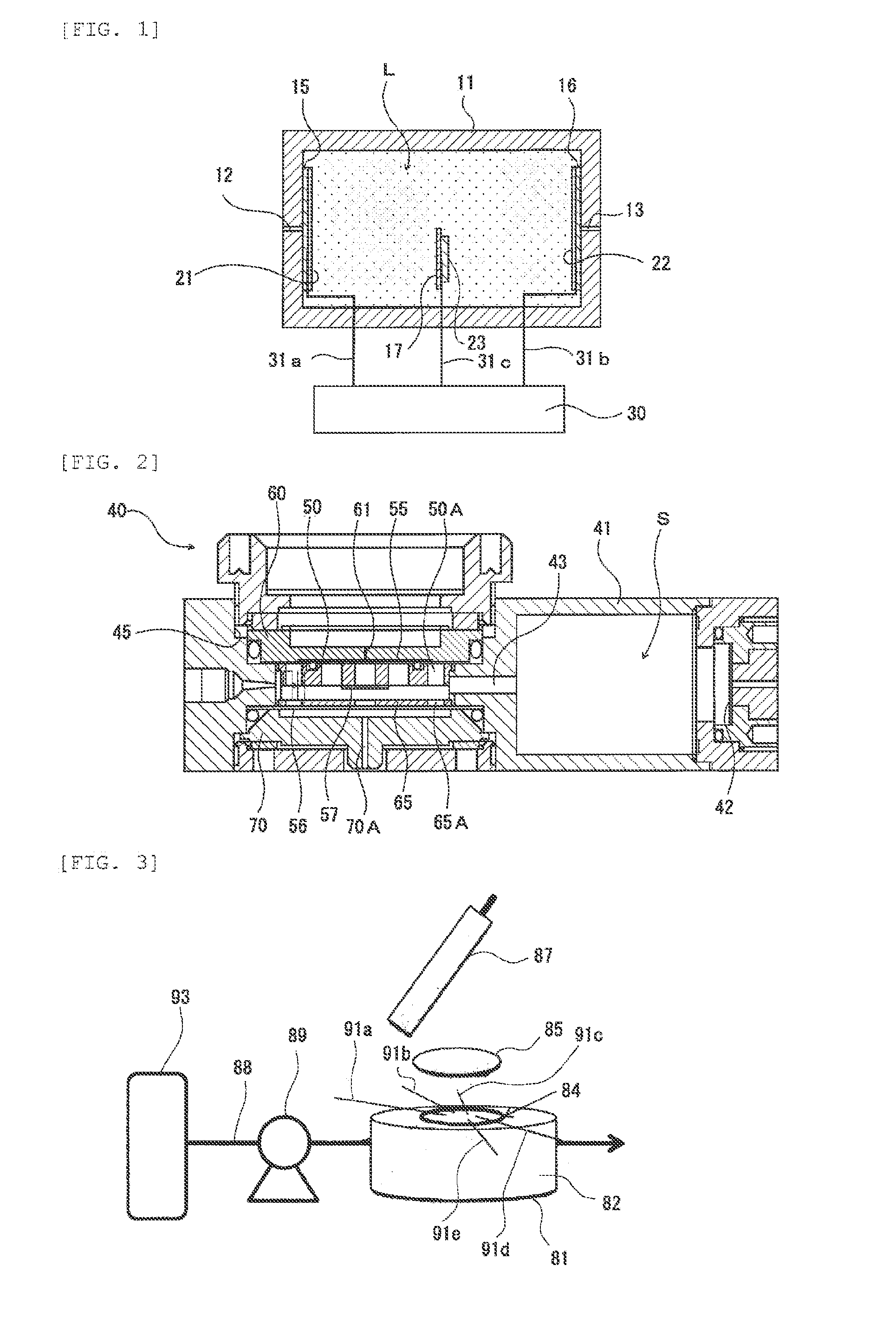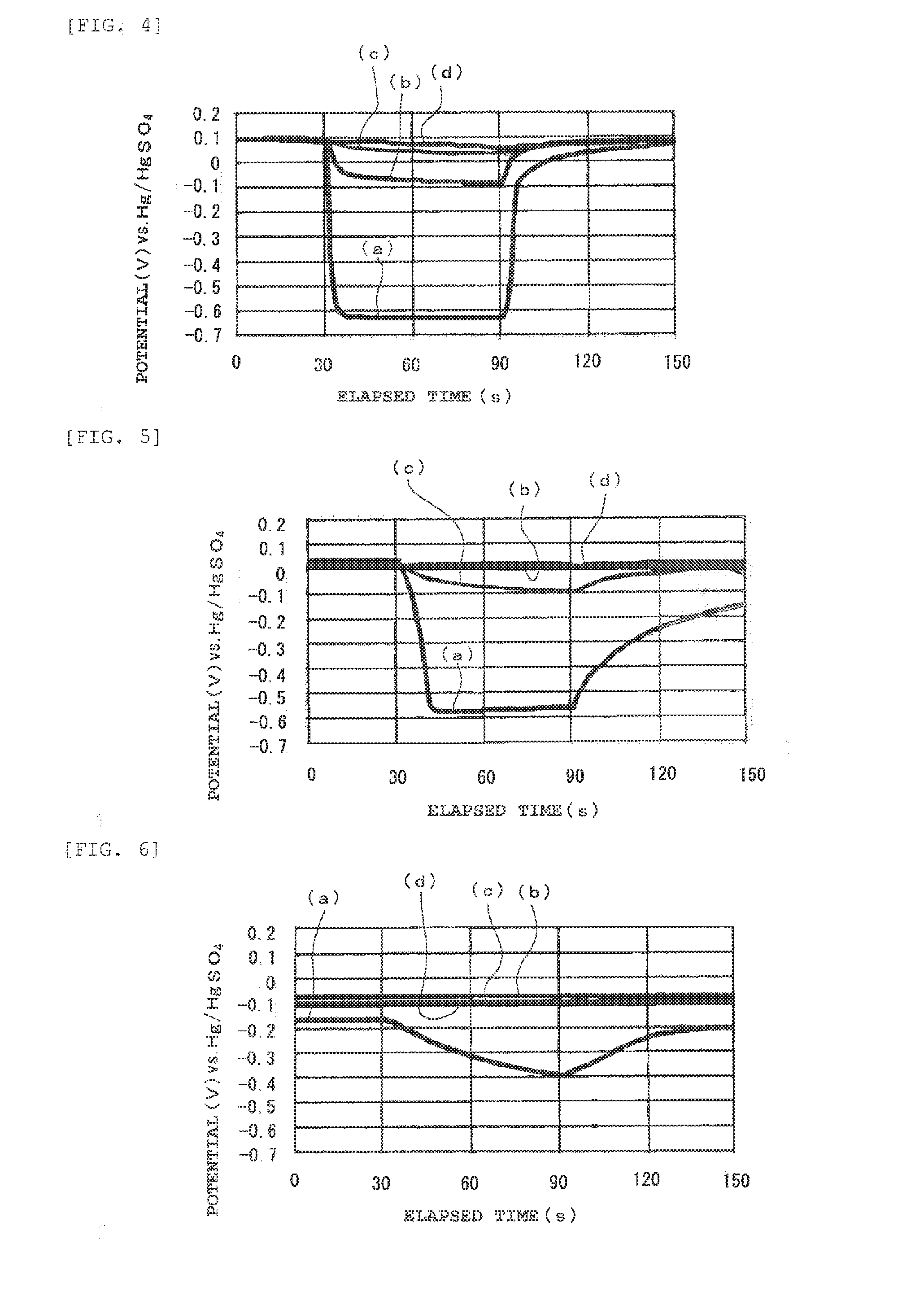Potentiostatic electrolytic gas sensor
a gas sensor and electrolytic technology, applied in the field of potentiostatic electrolytic gas sensors, can solve the problems of high index accuracy, inability to perform gas detection with high reliability, and inability to accurately detect gas, so as to reduce the occurrence of index errors, prevent or reduce the occurrence, and achieve accurate gas sensitivity
- Summary
- Abstract
- Description
- Claims
- Application Information
AI Technical Summary
Benefits of technology
Problems solved by technology
Method used
Image
Examples
experimental example 1
[0207]An experiment device (hereinafter also called “experiment device (1)”) having a structure shown in FIG. 3 was manufactured.
[0208]The experiment device (1) was provided with a container 81 in the shape of a cylinder with a bottom, which was formed with a gas inlet through hole and a gas outlet through hole at a peripheral surface 82. A circular porous PTFE membrane (trade name: “FX-030” (made by Sumitomo Electric Fine Polymer, Inc.)) 84 was attached to the container 81 with a double-sided adhesive tape so as to close an opening. On the top surface (top surface in FIG. 3) of the porous PTFE membrane 84, five kinds of metal wires 91a to 91e were disposed such that one end of each of the metal wires 91a to 91e was situated above the opening of the container 81, and a piece of circular filter paper 85 that was impregnated with a sulfuric acid having a concentration of 18N was disposed. That is to say, the five kinds of metal wires 91a to 91e were caught between the porous PTFE memb...
experimental example 2
[0218]A bipolar experiment device (hereinafter also called “experiment device (2)”) having working electrodes 103 and a counter electrode 104 was manufactured as shown in FIG. 9.
[0219]The experiment device (2) included a casing 100 accommodating an electrolytic solution L. A gas-permeable hydrophobic membrane 102 was placed sc as to cover a gas supply controller that was constituted of a gas inlet through hole 101 formed in the casing 100, from inside. The five working electrodes 103 were provided on the gas-permeable hydrophobic membrane 102 on the side of the electrolytic solution L. There was provided a mercury sulfate electrode as the counter electrode 104 in the casing 100, together with the five working electrodes 103, a distance away from the five working electrodes 103. As an internal liquid of the mercury sulfate electrode, a potassium sulfate (K2SO4) solution having a concentration of 0.35 mol / L was used.
[0220]In this experiment device (2), as the gas-permeable hydrophobic...
experimental example 3
[0227]An experiment device (hereinafter also called “experiment device (3)”) that had the same structure as the experiment device (2) other than provision of four working electrodes described below was manufactured.
[0228]The four working electrodes constituting the experiment device (3) were each made of a disk-shaped electrode catalyst layer having a diameter of 4 mm provided in a gas-permeable hydrophobic membrane. The four working electrodes included a platinum black electrode made of platinum black, a platinum monoxide electrode made of a platinum oxide (II) (PtO), a ruthenium electrode made of ruthenium (Ru), and an iridium electrode made of iridium (Ir). To be more specific, the platinum black electrode was formed by firing platinum black together with a binder at a firing temperature of 320° C., as in the case of the experimental example 2. The platinum monoxide electrode was formed by firing a platinum monoxide (II) together with a binder at a firing temperature of 320° C. T...
PUM
| Property | Measurement | Unit |
|---|---|---|
| thickness | aaaaa | aaaaa |
| porosity | aaaaa | aaaaa |
| thickness | aaaaa | aaaaa |
Abstract
Description
Claims
Application Information
 Login to View More
Login to View More - R&D
- Intellectual Property
- Life Sciences
- Materials
- Tech Scout
- Unparalleled Data Quality
- Higher Quality Content
- 60% Fewer Hallucinations
Browse by: Latest US Patents, China's latest patents, Technical Efficacy Thesaurus, Application Domain, Technology Topic, Popular Technical Reports.
© 2025 PatSnap. All rights reserved.Legal|Privacy policy|Modern Slavery Act Transparency Statement|Sitemap|About US| Contact US: help@patsnap.com



